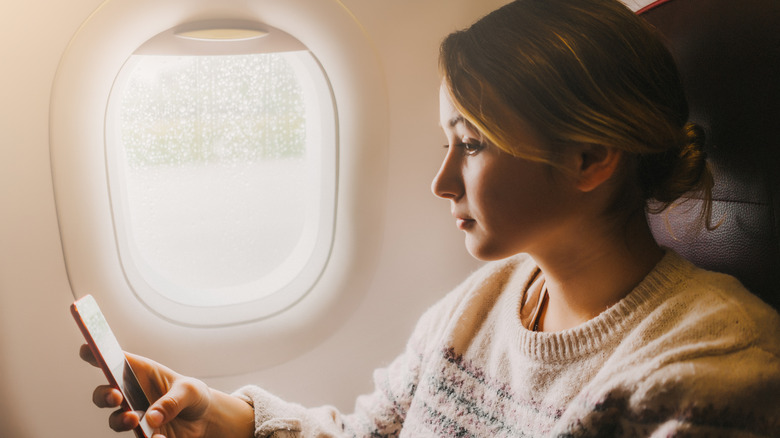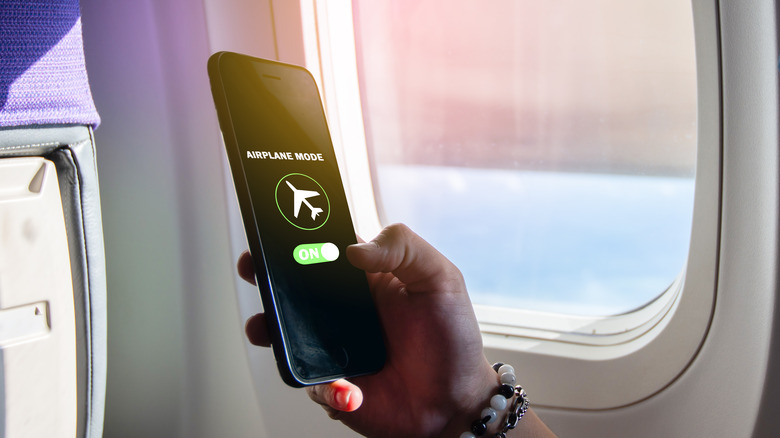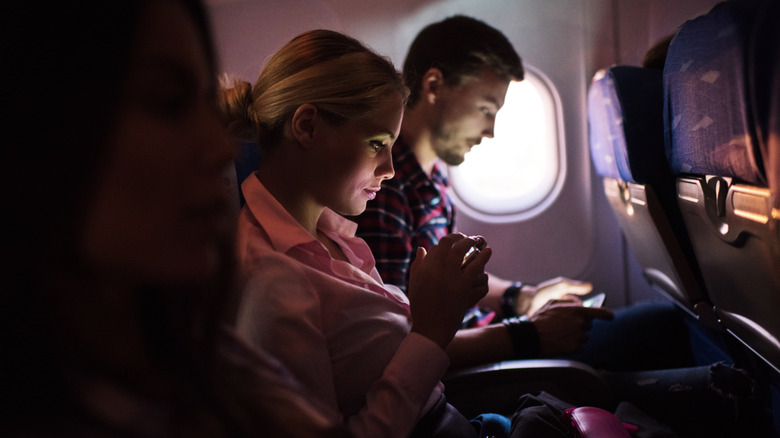What Actually Happens If You Don't Put Your Phone In Airplane Mode On A Plane
When it comes to air travel, you have to follow a long list of regulations, ranging from clear-cut mandates to unspoken rules. For starters, flight attendants hate when you pretend that your seatbelt is fastened. You must buckle up at all times, except for brief breaks. Taking your shoes off on a flight is frowned upon, and being extra mindful of others is appreciated when reclining your seat. Oh, and putting your phone on airplane mode is also required. It's even outlined in the Federal Aviation Administration (pdf) and Federal Communications Commission rules that using phones during flights is prohibited, subjecting rulebreakers to potential fines or "suspension." However, devices set to airplane mode are exempt from this rule under most circumstances. But do you really have to toggle your settings?
The short answer? Yes, if you don't want to defy FAA regulations — especially if a crew member tells you to do so. The rule exists in the first place to minimize the "potential interference to wireless networks on the ground," as noted by the FCC. As it turns out, phones can emit signals that disrupt a plane's navigational systems. A single phone not in airplane mode may not be powerful enough to cause a distraction, but imagine the chaos when everyone on board decides they're the exception. As former Boeing engineer Kenny Kirchoff explained to CNN, "It's not necessarily that a phone can bring down an airplane ... The issue is interfering with the airplane and causing more work for the pilots during critical phases of flight."
There's conflicting evidence regarding how phones affect flight safety
Aviation rules aren't just plucked from the ether, despite how it sometimes feels when dealing with many of them. When the FAA and FCC restricted the use of phones on flights in the 1990s, it appears that the decision was grounded in genuine concerns for flight safety. Over time, however, the perception of this rule has evolved, leading some to deem it antiquated.
In 2012, an FAA study (pdf) found "no confirmed occurrences" of phones causing safety hiccups. Two years later, the European Union Aviation Safety Agency, which is practically Europe's FAA, started allowing the use of mobile devices during flights following a "safety assessment process," albeit leaving the final decision to airlines. Interestingly, as far back as 2005, FAA associate administrator Nicholas Sabatini said in a congressional testimony that because of technological advancements, phone flight bans "may not be needed."
Pilots, too, have stated that smartphones are rarely a threat these days. In the subreddit r/flying for pilots and aviation professionals, one user claimed that a "static-like noise" used to be a common concern but has since become a rarity. Another user claimed they didn't use airplane mode while flying. "Cell phone interference doesn't exist, it's basically a myth at this point," they opined. "The worst interference you'll get is a hint of static on the radio or your compass moving a couple degrees from electro magnetic interference if you slap your phone on top of it."
But it doesn't hurt to put your phone on airplane mode anyway
With smartphones being advanced enough not to create serious disruptions or safety risks, inadvertently failing to switch your phone to airplane mode during a flight likely won't spell disaster. Then again, it also doesn't hurt to cling to the habit. As with all things aviation, it's always better to err on the side of caution. "Whilst systems have improved, the industry regulators take a cautious view because of the safety implications," a spokesperson from an international airline told CN Traveler.
However, if you must take your phone off airplane mode, avoid doing it during landing, arguably the most crucial part of any flight. "Where it really counts is upon landing, especially when we're doing an instrument landing," Shawn Pruchnicki, a professor at the Center for Aviation Studies at Ohio State University, explained to USA Today. "Those signals are very, very precise, and the autopilot flying those signals is also very, very precise. This is not the time when you want any variability at all, especially when you have terrain considerations."
That said, the chances of your phone sabotaging a flight are incredibly low, but they're never zero. But don't fret; the rules may change soon, as evidenced by the European Commission's 2022 ruling allowing 5G, data, and calls on certain aircraft. Until then, maybe give that airplane mode toggle a tap on your mobile and streaming devices. And make sure you listen to crew member instructions to avoid potentially being charged with a federal offense.


